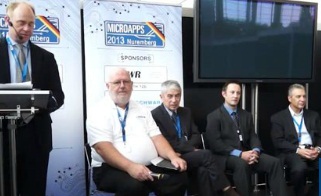The RF/microwave semiconductor market is poised to undergo some major shifts in the not too distant future with recent news of mergers between leading GaAs-based integrated device manufacturers, RFMD and TriQuint, CMOS-based RF front-ends for multi-mode, multi-band mobile devices from Peregrine and Qualcomm and the continued success in commercializing GaN by a number of vendors. As GaN and CMOS semiconductor processes continue to improve performance and reduce costs, market share will undoubtedly shift between players.
The April issue cover feature looks at one of the technologies driving that change, namely envelop tracking and related technologies that are allowing RF power amplifiers to achieve unprecedented efficiency and linearity. In our May issue, our cover story (in addition to our IMS show coverage) looks at a potentially disruptive approach to communication ICs based on millimeter-wave silicon core IPs coupled with minimal GaAs front-end technology. And in June, our semiconductor issue will look at two instances where device manufacturers are challenging the status quo by greatly reducing the cost of high-performance GaN-based devices and by pushing highly integrate-able CMOS PA performance into the realm currently dominated by GaAs.
These themes were present at this year’s EDI CON event in Beijing China, where leading GaN device manufacturers presented numerous papers on GaN performance, designing with GaN and GaN characterization techniques to an engaged audience of fellow engineers. Peregrine’s workshop on its UltraCMOS as a complementary technology to GaN drew a standing room only crowd. And the papers on new amplifier architectures such as envelop tracking and digital pre-distortion from several authors were also among the most popular based on attendance.
Six months earlier at the MicroApps at European Microwave Week (Nuremberg, Germany), the attributes of various semiconductor technologies relevant to specific applications was the topic of a special panel session that I had the pleasure of moderating. Joining this panel discussion were technologists from Cree, TriQuint, OMMIC, Win Semiconductor and UMS. In addition to offering their own products, these experts could talk on behalf of their respective semiconductor foundry services, advising the audience on how to align available semiconductor process technologies with the requirements of a given application. With this topic continuing to create choice and change in the market, I encourage engineers to take a look at their comments in the video recording of this panel and consider your own questions for these vendors as you prepare to head down to Tampa for the International Microwave Symposium. This topic conitnues to be as hot as Tampa in June
Aligning Semiconductor technologies to RF applications panel video
Sponsored by AWR, a National Instruments Company



Recent Comments
Professor Prem raj Pushpakaran writes -- 2023 marks...
The truth will come out in 2069.Some patience...
obviously they used alien technology duh...
The problems created by the weak nuclear bond...
John